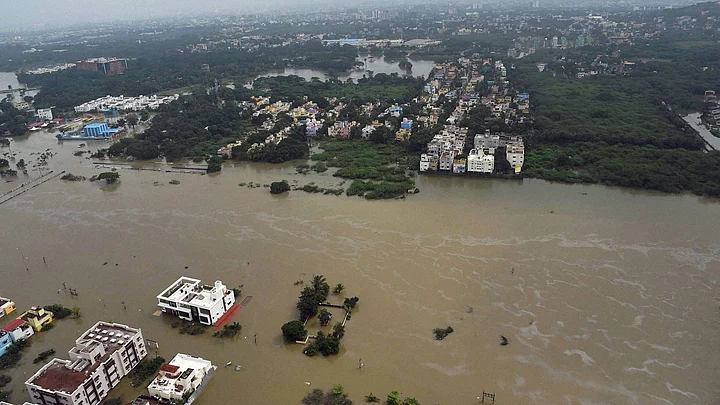As I watch the improbable images of rescue boats, not cars, operating in the flooded streets of Chennai on my TV screen, I know I am witnessing the impact of a weather-related disaster. In my gut, however, I sense I will be seeing many such improbable images from many other Indian cities in the future.
Why?
Few people will deny that the threat of global warming is real. The 2014 Fifth Assessment Report of the Intergovernmental Panel on Climate Change (IPCC) clearly says that the coastal regions of Asia, particularly the urban areas, could face some of the most devastating effects of climate change such as extreme heat and rain, flooding, rise in sea level etc. Coastal cities have always lived with natural hazards but climate change will increase the frequency and possibly the intensity of such natural calamities.
Poor Urban Planning
India has a 7,517-km long, densely populated coastline. 250 million people, or 20 per cent of our population, lives within 50 km of the coast. This includes 25 coastal cities with a population of over 1 million, each a potential disaster zone. None of these cities are planned enough or developed to withstand a weather-related disaster of the scale we are witnessing in Chennai today.
Most of these cities have a “development deficit” from the challenges of rapid urbanisation, poor urban planning, high population density, expanding informal settlements, inadequate infrastructure and environmental degradation from uncollected solid waste, untreated wastewater as well as from destruction of existing (natural) hazard protection systems such as drainage channels, wetlands, floodplains, fresh air corridors or vegetation.
Disaster In the Making?
The adverse impact of the unprecedented rains in Chennai has primarily been attributed to unrestrained construction in fragile flood-prone areas under successive administrations. The Chennai Master Plan 2026 is partly responsible as it states no area in Tamil Nadu falls in the flood-risk zone according to the hazard map of India!
Even though it inserts caveats for area-based flood mapping in urban areas, it allows for development in flood-prone areas subject to PWD clearance. For powerful developers this is not a difficult task, as is proved by the many large infrastructure, SEZ and new housing projects located on ecologically fragile areas in Chennai. Under these conditions, Indian cities are extremely vulnerable to extreme weather-related events and have limited resilience to quickly bounce back.
What Can India Do?
- Develop and enforce sound land use plans in our cities, based on accurate mapping of ground realities.
- Mandate dense, mixed-use developments in resilient parts of cities supported by public transport, build hazard-reducing infrastructure.
- Preserve and protect natural drainage systems, dense vegetation, wetlands, and relocate facilities out of flood-prone areas.
- Penalise developers who encroach on ecologically sensitive areas, municipal bodies for failing to provide basic services to all citizens, and citizens who throw garbage in drains.
- Engage all stakeholders in rethinking Indian cities in the light of climate variability when it is very likely that monsoons will increasingly become unpredictable.
Lessons from Tokyo
The common learning from the floods in Mumbai, Srinagar and now Chennai is that urbanisation through bad or no planning or in violation of planning had a big role to play in intensifying the scale of the impact. This requires both mitigation (proactive risk management) and adaptation (proactive adjustments to negative impact while exploring potential opportunities) in cities to respond to the threats and risks of extreme weather.
An example of mitigation to reduce flood risks in a city can be found in Tokyo, Japan. Despite being ravaged by heavy rains every typhoon season, Tokyo today has emerged as one of the most resilient cities in the world. This was achieved, to a large extent, by putting in place the world’s largest underground flood water diversion facility to mitigate the risk of overflowing rivers and waterways during heavy rainfall. This includes big concrete reservoirs interconnected by 6-km long concrete tunnels built 50 metres under the city with the ability to pump 200 tonnes of water per second.
Other measures include investing in green infrastructure, controlling urban sprawl through compact city planning, and transit-served development supported by a fantastic public transport system among other strategies.
Where Does the Solution Lie?
If we have to adapt Indian cities to reduce the risks posed by climate change, we must at least develop and enforce sound land use plans in our cities which are based on accurate mapping of ground realities (for instance, not marking slums as build-able vacant land) and assessment of climate vulnerabilities.
We also need to mandate dense, mixed use developments in resilient parts of cities supported by public transport; provide security of tenure and basic services in slums and build hazard-reducing infrastructure in them (e.g. drainage systems, roads allowing emergency vehicle access); preserve and protect natural drainage systems, dense vegetation, wetlands, and relocate facilities out of flood-prone areas.
We should penalise developers, public or private, who encroach on ecologically sensitive areas, municipal bodies for failing to provide basic services to all citizens, and citizens who throw garbage in drains. We need to engage all stakeholders in rethinking Indian cities in the light of climate variability when it is very likely that intensity and frequency of monsoons will increase in unpredictable ways.
(The writer is an urban designer who works on climate change adaptation issues.)
